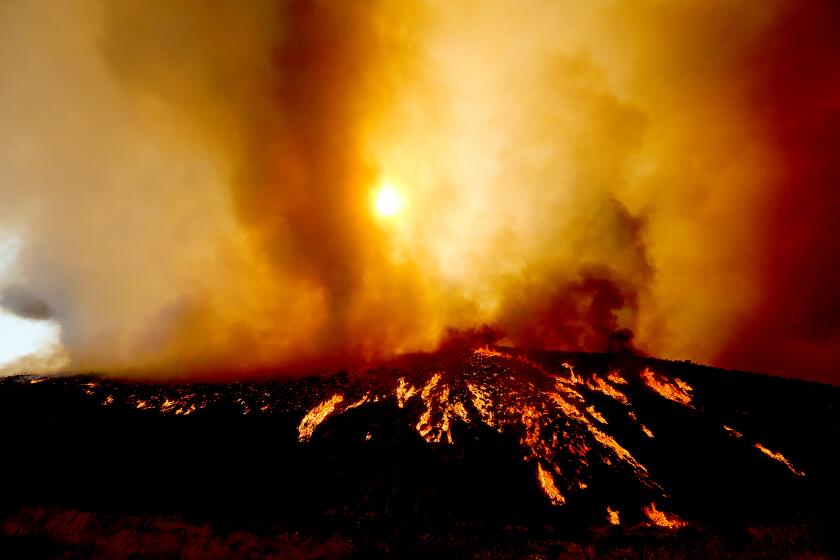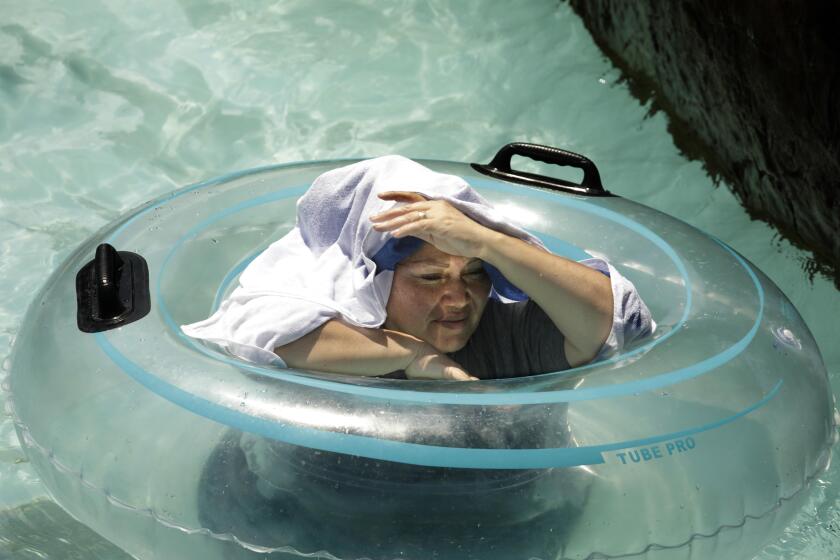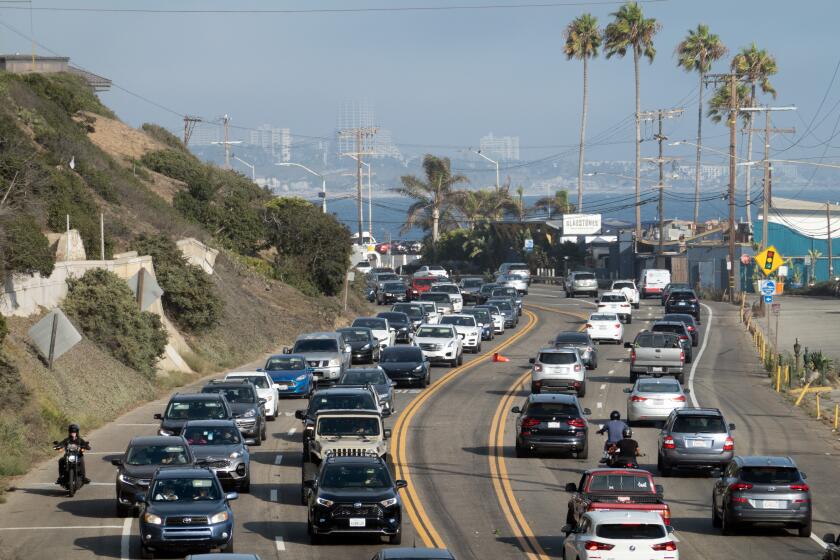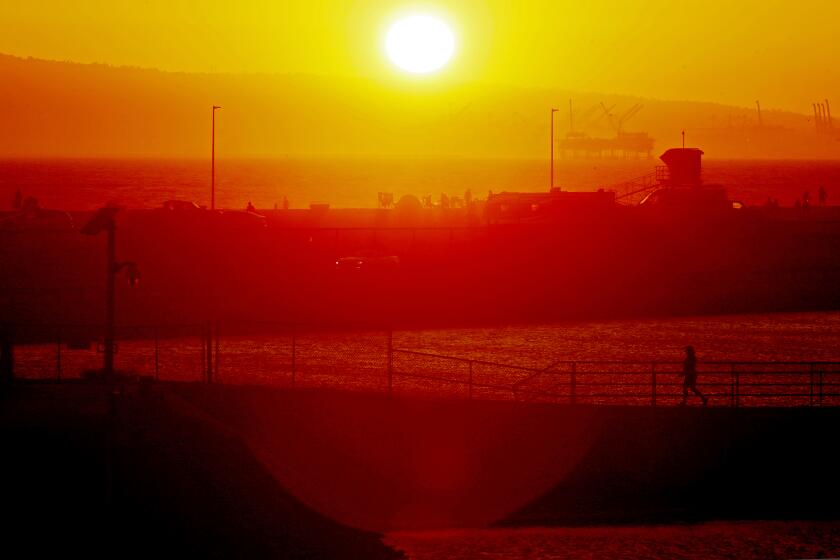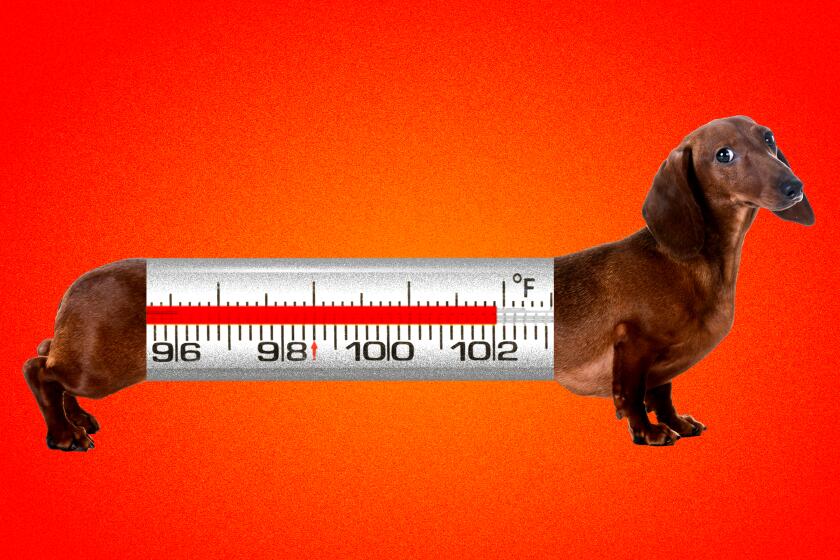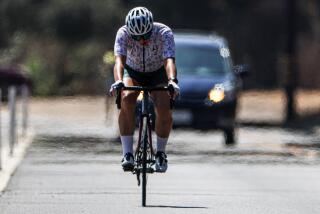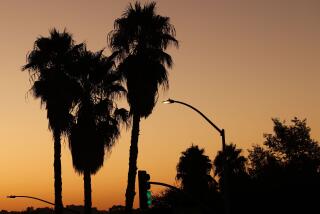California averts widespread rolling blackouts as energy demands ease amid heat wave

- Share via
For nearly three hours Tuesday night, California officials warned of imminent rolling blackouts as the state’s electrical grid struggled to keep up with surging demand during a punishing heat wave.
The Golden State avoided widespread outages, though three Northern California cities experienced brief losses of power.
At 8 p.m., the California Independent System Operator downgraded its level 3 alert, the final step before calling for rolling blackouts, saying that “consumer conservation played a big part in protecting electric grid reliability.”
There were “no load sheds for the night,” the grid operator said; however, Alameda, Palo Alto and Healdsburg officials said they implemented short “rotating outages.”
In Alameda, municipal utility officials said at 6:20 p.m. that rotating outages were beginning. Power would be shut off to two circuits for one hour, according to Alameda Municipal Power.
The fire tore through 2,000 acres around Hemet on Monday and continued to grow Tuesday .
Just before 7:30 p.m., utility officials in the Bay Area city said the second hour of power interruptions had been called off.
“No more rotating outages for tonight,” the utility said in a tweet. “Crews are working to get power restored to all customers shut off in the initial hour of outages.”
City officials in Healdsburg confirmed outages around 6:30 p.m.
“As directed by CAISO, rolling power outages to begin,” according to a Facebook post by the Sonoma County city.
Outages lasting about an hour per zone would cycle through each block until the energy shortage is over, the city officials said.
“Due to lower system loads, the need for rotating outages has ended,” city officials said at 8:10 p.m.
Palo Alto officials said around 7 p.m. that they had been cleared to restore power to about 1,700 customers after outages to meet Cal ISO’s “load-shedding requirements.”
“We did not order rotating outages,” Anne Gonzales, an ISO spokesperson, said in an email to The Times on Tuesday night. “We held at [Energy Emergency Alert] 3 with no load shed, and [the alert] ended at 8 p.m.”
Gonzales did not respond to several requests for clarification by phone.
Though some progress has been made, there have also been setbacks, including some proposed state legislation that has stalled.
Shortly after 7 p.m., Cal ISO noted that peak grid demand had hit 52,061 megawatts, “a new all-time record.”
The alert did not affect Los Angeles Department of Water and Power customers, as the utility operates its own grid and is separate from Cal ISO.
“We’re not suspecting any blackouts due to energy shortages and are not a part of any rolling blackouts [Cal ISO] has planned,” said Mia Rose Wong, a spokesperson for the municipal utility.
The DWP forecast Tuesday’s demand to be elevated but not enough to surpass available electrical generation and reserve capacity, Wong said.
Nevertheless, the utility advised its customers to conserve power and follow the state grid regulator’s guidance, including setting thermostats to at least 78 degrees and not using large appliances.
In addition to urging its customers to reduce energy use, the DWP makes excess power available to Cal ISO when available, Wong said, though it was not clear whether there was any excess power Tuesday night.
The heat wave is now expected to last through Friday, but the worst of it could be over for the southern half of the state — even as temperatures remain dangerously high.
For much of Northern California, the heat was expected to peak Tuesday, but temperatures are predicted to remain well above average through the week, according to the National Weather Service.
By late Tuesday afternoon, the weather service confirmed that downtown Sacramento had set an all-time temperature record. A preliminary high of 115 degrees broke the previous record of 114 set on July 17, 1925, meteorologists said. About an hour later, officials reported that the temperature had topped out at 116.
The state capital has seen a barrage of extremes over the last year, Daniel Swain, a climate scientist at UCLA and California climate fellow at the Nature Conservancy, said in a tweet Tuesday evening.
“First its longest dry spell on record, which ended with wettest day on record, followed by driest start to a calendar year on record, now followed by its hottest day on record,” Swain wrote.
In Hanford, the weather service office stated that as of 3 p.m., “all major weather reporting airports in the San Joaquin Valley have set daily record temperatures.”
Four cities in the Bay Area broke maximum temperature records tallied on any day of the year, according to the weather service.
San Jose’s temperature of 109 Tuesday beat the previous all-time high of 108, set Sept. 1, 2017.
Santa Rosa’s high of 115 broke the high of 113 set in 1913; Napa’s 114 broke the record of 113 set in 1961; and King City in Monterey County hit 116, breaking the record of 115 set in 2017.
Redwood City in San Mateo County hit 110, tying the record set in 1972.
Livermore topped out Tuesday at 116, tying the record set a day earlier. The previous maximum temperature recorded in Livermore was 115, set Sept. 3, 1950.
The state will need to make good on a number of other promises to achieve its climate goals. Here’s how California is faring toward those goals.
In a video posted to Twitter on Tuesday, Gov. Gavin Newsom called the heat across California unprecedented, and warned that the state is headed into the most severe stretch.
“The risk for outages is real, and it’s immediate,” Newsom said. “These triple-digit temperatures throughout much of the state are leading, not surprisingly, to record demand on the energy grid.”
He said the heat wave is “on track to be the hottest and longest on record” for California and parts of the West for September.
The West has long experienced episodes of extreme temperatures, but studies have shown that human-caused climate change is making these heat waves more prolonged, frequent and intense.
Heat tips
Stay informed
You can monitor your area’s forecast by going to the National Weather Service’s website and searching by city, state or ZIP Code for the latest weather updates and alerts. Follow local officials and agencies on social media for tips and information on available resources in your area. Keep an extreme heat checklist to make sure you are prepared.
Stay indoors and dress in light clothing
Officials from the National Weather Service and public health offices advise people to stay indoors as much as possible, particularly between 10 a.m. and 3 p.m., when the sun is strongest. If you exercise outdoors, it’s recommended to do so early in the morning or later in the evening.
If you don’t have air conditioning, the Centers for Disease Control and Prevention recommends going to a mall or public library. You can also refer to your county’s website or call the local health department to learn about cooling centers in your area. Other options include taking a cool shower twice a day or even finding a shaded yard or park. (Health officials at UCLA say electric fans will not prevent heat-related illnesses when temperatures reach the high 90s and above.)
An excessive heat watch is in place for much of Southern California this week. Keep yourself, your kids and your pets safe during hot temperatures with these tips.
Watch out for heat-related illnesses
According to the CDC, heat-related illnesses can range from heat rashes and sun burns to more serious conditions, including heat exhaustion and heatstroke, and result from the body’s inability to cool down by sweating. Signs of heatstroke, the most serious of the heat-related illnesses, include a temperature of 103 degrees or higher; hot, red, dry or damp skin; fast, strong pulse; headache; dizziness; nausea; confusion and losing consciousness. If you’re experiencing these symptoms, seek immediate medical attention. The CDC advises against drinking anything and recommends moving to a cool place and into a cold bath or using a cold cloth.
Signs of heat exhaustion include heavy sweating; cold, pale and clammy skin; a fast, weak pulse; nausea or vomiting; muscle cramps; fatigue; dizziness; headaches and fainting. If you’re showing these symptoms, get out of the sun immediately, seek a cool place or cool towels and sip water. Monitor your symptoms and get help if you are vomiting, if the symptoms worsen or if they last longer than an hour.
Stay hydrated
Drinking plenty of fluids, particularly before going outdoors, is critical in preventing heat-related illnesses. Officials at UCLA warn against waiting until you’re thirsty to drink. During times of extreme heat, it’s best to drink at least two to four cups of water per hour. (For those working outside, the CDC suggests one cup of water, or 8 ounces, every 15 to 20 minutes.) Health officials also advise against drinking alcohol during times of extreme heat, as it causes dehydration and increases the risk of heat-related illnesses.
It’s also important to replenish the salt and minerals your body loses when it sweats by drinking low-sugar fruit juices or sports drinks. Dietitians also recommend eating foods with high water content — think watermelon, celery and cucumbers — along with drinking the right fluids.
Signs of dehydration in adults include extreme thirst; fatigue; dizziness; lightheadedness; dry mouth and/or lips, and infrequent urination. In infants or young children, look for dry mouths and tongues; no tears when crying; no wet diaper for more than three hours; sunken eyes and cheeks; a sunken soft spot on top of their head, and irritability or listlessness.
(If your doctor has you on a particular diet, or regulates how much water you drink, ask about what steps you should take during heat waves to stay properly hydrated.)
If you think it’s hot outside, then your pet is definitely feeling it. Here are tips on how to keep your furry friends cool in the heat.
Check on the most vulnerable
In addition to keeping yourself safe and healthy, check in frequently with those who are at high risk, including seniors, children, pregnant women, the unhoused, those who work outside and those without air conditioning. Heat also affects your pets, so keep them indoors, or if they will be outside, make sure they have plenty of water and a shaded area. Never leave a child or pet in the back seat of a car, as temperatures inside a vehicle can quickly skyrocket, even with windows cracked.
To help homeless people, the Los Angeles County Department of Public Health suggests donating water, electrolyte packages, light and loose-fitting clothing, tents, towels and other supplies to local organizations.
Times staff writer Rong-Gong Lin II contributed to this report.
More to Read
Sign up for Essential California
The most important California stories and recommendations in your inbox every morning.
You may occasionally receive promotional content from the Los Angeles Times.
